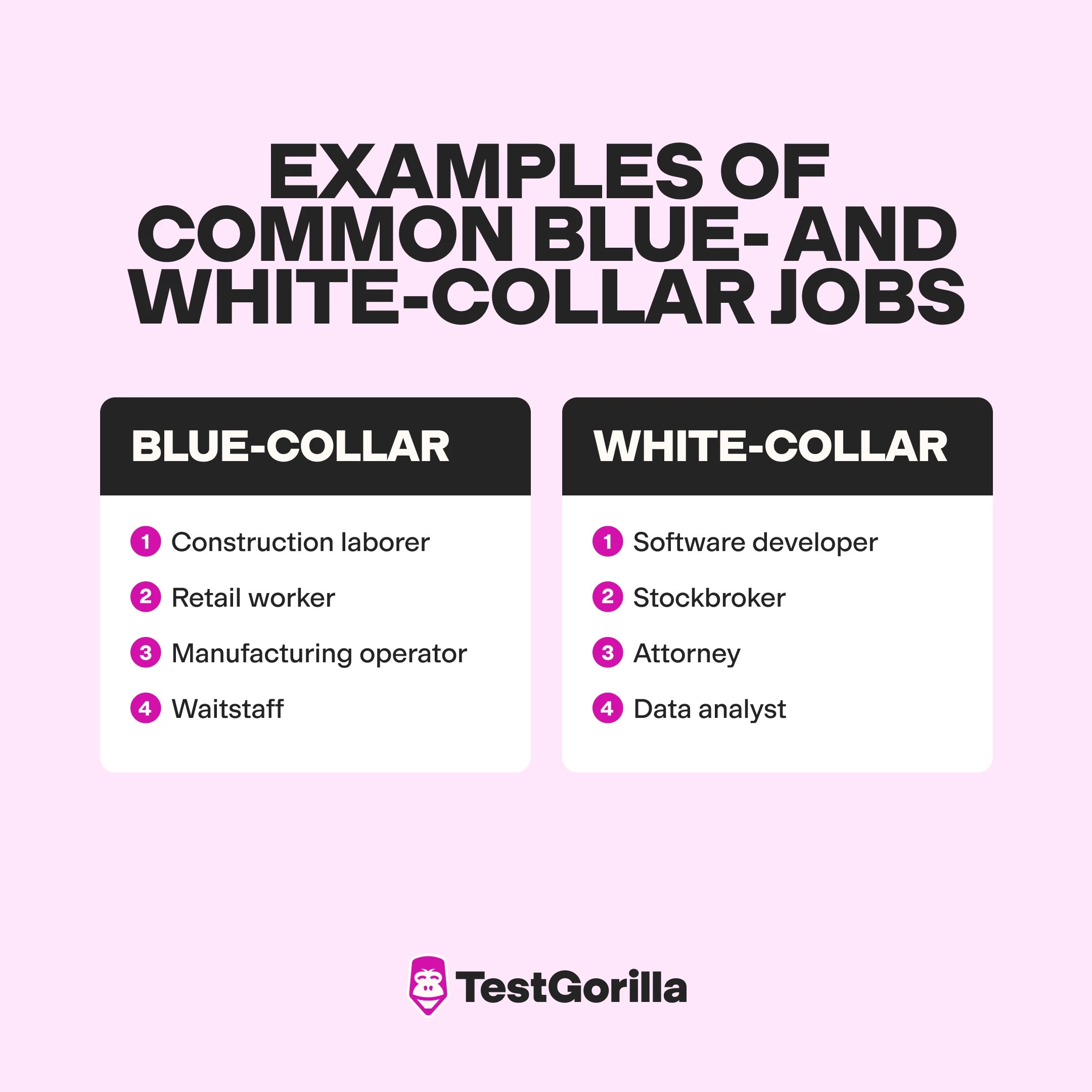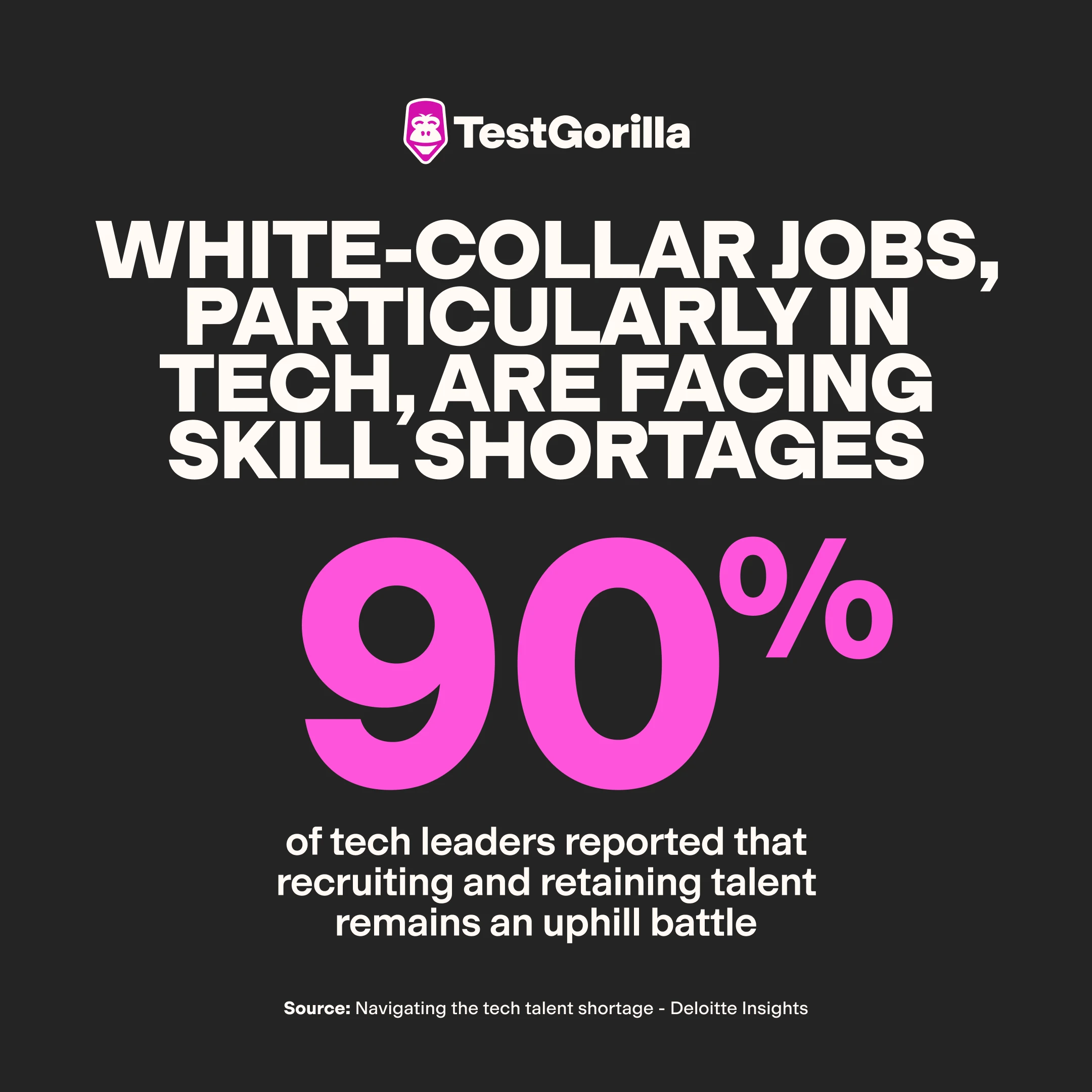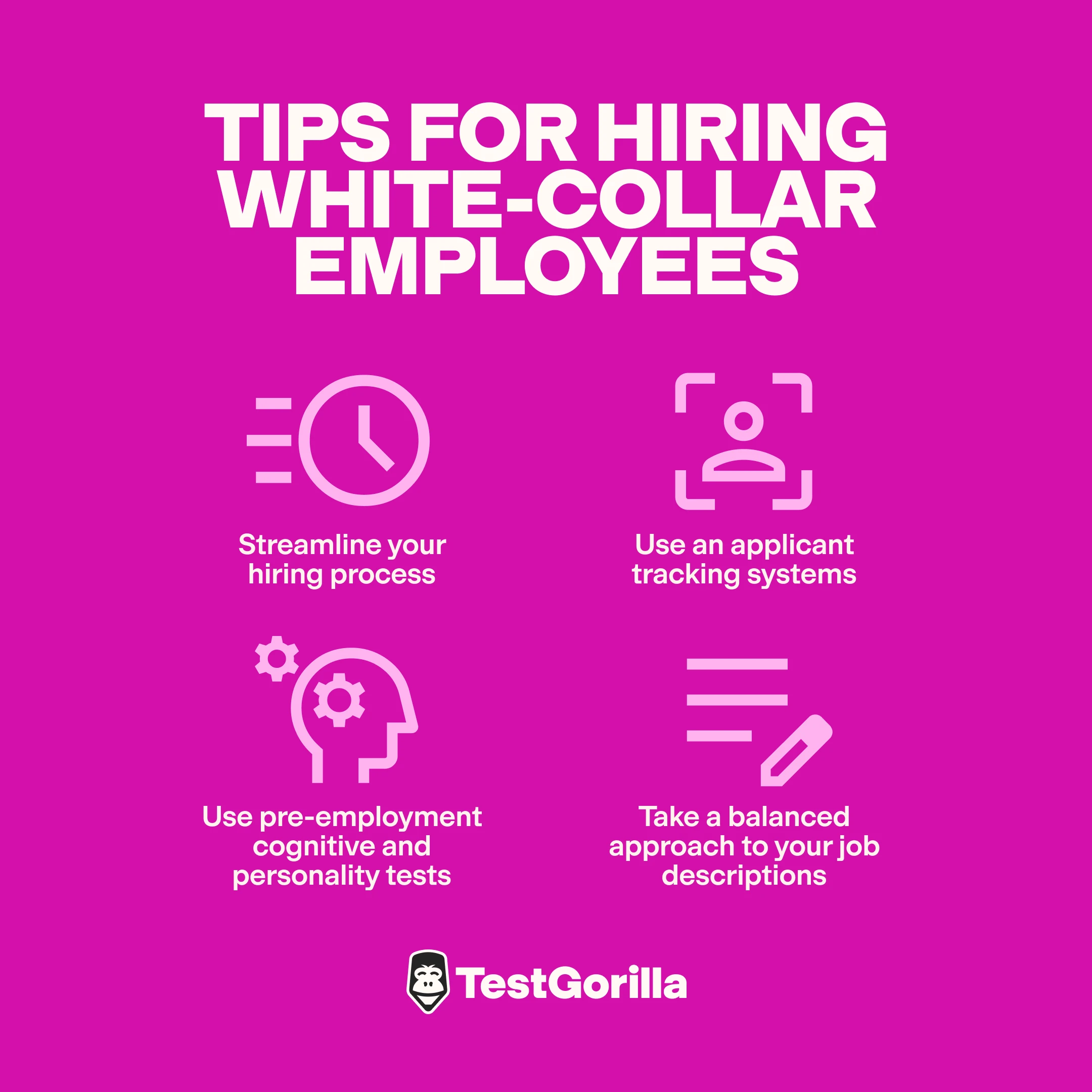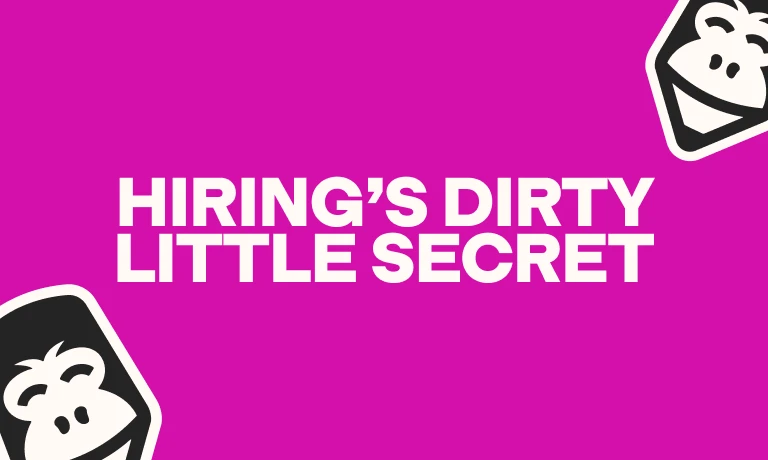White-collar vs. blue-collar recruitment: Key differences for hiring
Recruitment isn’t a one-size-fits-all process, especially when it comes to white-collar vs. blue-collar roles. The strategies that land top software engineers won't always work for hiring a carpenter, for instance.
But which strategies should you use to land the best talent for your blue- and white-collar roles? And how, exactly, are the two types of recruitment different?
We break it all down for you in this guide.
Below, we explore the unique challenges of recruiting for white-collar and blue-collar roles and provide targeted strategies for each. Plus, we reveal how skills-based hiring bridges the gap between them.
Table of contents
Key takeaways
White- and blue-collar recruitment have distinct recruitment channels, screening and interviewing processes, challenges, and blind spots.
White-collar recruitment is more about streamlining the hiring process and identifying top talent. It’s also almost exclusively online.
Blue-collar recruitment is more about navigating skill shortages, expanding your candidate pool, and locking in rare talent. It’s typically local and informal.
Skills-based hiring makes recruitment for both collars easier and improves the quality of hires.
White-collar vs. blue-collar: What’s the difference when it comes to recruitment?
White-collar roles typically involve degree qualifications and are office-based or administrative. Blue-collar roles are more hands-on and involve physical work. Some don’t require formal qualifications; others do and are considered “highly skilled.” Here are some examples of common blue- and white-collar jobs:
Blue collar:
Construction laborer
Retail worker
Manufacturing operator
Waitstaff
White collar:
Software developer
Stockbroker
Attorney
Data analyst
💡Some roles straddle both categories, such as:
Technicians
Construction managers
Engineers
Police officers
These are often referred to as “gray-collar” jobs.
With this in mind, here are some differences in recruiting between the two:
Recruitment channels
Blue-collar recruitment tends to be more traditional and local. Think word-of-mouth, local job boards, job fairs, industry-specific conventions, trade publications, trade schools, and staffing agencies. As younger, more tech-savvy people enter the workforce, we’ve seen more blue-collar job postings online on sites like Indeed and even social media.
White-collar recruitment channels tend to be almost exclusively online. LinkedIn and Glassdoor are the largest and most popular networking and recruitment platforms for white-collar recruitment. Headhunting is also common, as are white-collar recruitment agencies and professional networking.
Screening and interviewing process
The typical interview and screening process for blue-collar jobs is relaxed and informal. A standard interviewing process might include a quick phone call, a short interview, and a brief trial period to see the candidates' skills in action. As a result, the average time to hire is much shorter, usually under 25 days (depending on the industry).
White-collar screening and interviewing are usually more intensive. The process typically comprises 2-3 interviews, and there’s a tendency to focus on qualifications and past experience when assessing candidates. It can be an unwieldy process that takes an average of 42 days to complete.
Challenges and blindspots
Reversing a decades-long trend, it’s currently harder to fill skilled blue-collar jobs than white-collar jobs. This is partially due to an aging blue-collar workforce and a declining interest in blue-collar work in younger generations. The challenge with blue-collar recruitment is finding and locking in the right people.
White-collar jobs, particularly in tech, are also facing skill shortages. Even after the mass layoffs that occurred in 2023, 90% of tech leaders reported that recruiting and retaining talent remains an uphill battle.
The additional problem in white-collar recruitment is determining how to identify the right person for the role. The over-reliance on credentials and resumes in white-collar recruitment leads to costly mis-hires. A staggering 50% of hires in white-collar roles are later found to not have the right skills for the role due to biased or ineffective recruitment strategies!
The best insights on HR and recruitment, delivered to your inbox.
Biweekly updates. No spam. Unsubscribe any time.
Tips for hiring white-collar employees
In 2023, 86% of business leaders agreed that the cost of a bad hire is more severe than it was a year ago – signaling that it’s more important now than ever to nail your white-collar hires.
Here are some tips to help you secure the right talent:
Streamline your hiring process. White-collar candidates are often pursued by multiple recruiters, so you need to act quickly to secure them. Keep the process rolling by excluding any unnecessary parties in hiring decisions and booking follow-up interviews as close together as possible.
Use an applicant tracking systems (ATS). In white-collar recruitment, you’ll likely have a lot of applicants to track and keep in contact with. You can automate parts of the hiring process, such as sending candidates emails and scheduling interviews, and reduce time to hire.
Use pre-employment cognitive and personality tests. These enable you to identify candidates’ cultural add, behavioral traits, and potential to mesh well with your team – all critical in white-collar roles where problem-solving and adaptability are essential.
Take a balanced approach to your job descriptions. White-collar candidates often seek more than just a paycheck. So, emphasize the required – and desired – skills and qualifications for the role but also highlight salary, growth opportunities, and company culture.
🔎 For even more tips, check out our guide on recruiting for white-collar jobs.
Tips for hiring blue-collar employees
A lot of the concepts and processes – and even the language itself – in white-collar recruitment would be alien in blue-collar recruitment.
This type of hiring is informal and fast. Using an ATS, for example, would be unnecessary because the process is usually one interview and a quick trial. Also, consider that skilled blue-collar employees are in short supply, and you don't want to include any unnecessary barriers to getting them in the door.
Considering these points, here are some tips for your blue-collar recruitment efforts:
Use employee referral systems. Blue-collar workers often know many skilled professionals – ones who could be a perfect fit for your open role. Ask your employees for referrals, and, if possible, offer incentives (like a cash bonus) for bringing in top talent.
Waste no time locking talent in. Things move fast in blue-collar recruitment, and top talent is hard to come by. Keep your hiring process short by using effective screening tools (more on this in a moment), minimizing the number of interviews, and making offers quickly.
Don’t forget to sell yourself: When skills are in demand, blue-collar candidates have their pick of the best employers. Make it clear that you are the best employer by selling candidates on the monetary and non-monetary benefits of working with you.
Appeal to digital natives: One of the major causes of the blue-collar skill shortage is the age divide. As digital natives, Gen Z is less likely to come across “IRL” (“in real life”) recruitment strategies that are typical of the blue-collar space. So, digitize your blue-collar recruitment by posting job ads on social media and using other tech-based recruitment solutions (more on this below).
🔎 For even more tips, check out our guide on recruiting for blue-collar jobs.
Skills-based hiring: Getting around the collar divide
When it comes to making the right hiring choices, more and more companies are shifting away from relying on resumes and credentials and toward skills-based hiring. But what is skills-based hiring? It’s a recruitment approach that prioritizes a candidate’s abilities and competencies over traditional markers like degrees or past job roles. You can use it to hire for both blue- and white-collar jobs across all industries and seniority levels.
Online talent assessments, like the ones TestGorilla provides, are central to a skills-based approach. They allow you to test candidates on the skills they’ll be using in the role – from job-specific skills to soft skills such as communication, adaptability, and problem-solving.
Need more guidance on implementing skills-based hiring?
Read our complete handbook for all the tips, tools, and strategies you need to get the most out of this transformational approach to recruitment.
Let’s say you’re hiring a warehouse manager. You run a tight ship, and need somebody who’s great at managing their time, good at solving problems, and has the right skills and knowledge for the job. You could together a stack of online tests for time management, problem-solving, and warehouse supervisor skills and knowledge to find the right person for the job.
Likewise, say you’re hiring a business analyst. You need somebody with the right programming and data visualization skills who’s a critical thinker with a strong attention to detail. You’d test for IT business analyst skills and knowledge, critical thinking, and attention to detail.
Here’s how taking a skills-based approach can help in blue- and white-collar recruitment:
Simplifies multi-round interview processes that don’t always identify the skills you’re looking for.
Helps you process applicants faster and reduces candidate dropout rates.
Reduces bias and improves diversity by focusing on skills.
Broadens the candidate pool to those who may not have the qualifications but do have the skills.
Minimizes training costs often incurred after bad hiring decisions.
Reduces costly mis-hires.
🔎 Curious about the other benefits of skills-based hiring? Check out our 2025 State of Skills-Based Hiring Report.
Get your next blue- or white-collar hire right with TestGorilla
There are key differences in effective recruitment for blue- and white-collar jobs. White-collar recruitment is traditionally more intensive, tech-based, and formal. Key challenges include optimizing the hiring process and overcoming reliance on credentials for hiring decisions. Blue-collar recruitment is usually quicker and more informal. Challenges include navigating major skill shortages and broadening the hiring pool to fill in-demand roles.
However, a skills-based hiring approach is the reigning champion for finding top talent no matter what type of recruitment you’re doing. And TestGorilla is the perfect solution.
Our test library contains hundreds of science-backed tests that test for job-specific and soft skills that cater to both blue- and white-collar roles. Get started today for free, or register for a 45-minute demo and see how TestGorilla can help you make smarter hiring decisions.
FAQs
How can technology streamline white-collar vs. blue-collar recruitment?
Technology can streamline white-collar vs. blue-collar recruitment by automating tasks like resume screening, candidate matching, and skills assessments. Tech can also help target candidates with specific qualifications, and mobile-friendly platforms and automated job postings can reach a wider audience of skilled workers.
What interview techniques work best in white-collar vs. blue-collar recruitment?
Effective interview techniques differ in white-collar vs. blue-collar recruitment. For white-collar roles, behavioral and competency-based interviews are common, focusing on problem-solving abilities, leadership skills, and cultural fit. In blue-collar recruitment, practical assessments and technical questions are often more relevant, as they help determine a candidate's hands-on abilities and readiness for specific tasks.
You've scrolled this far
Why not try TestGorilla for free, and see what happens when you put skills first.






















